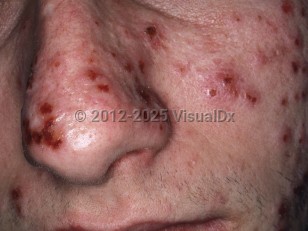The etiology is unknown but postulated to be immune in nature. The disease has been associated with chronic or latent Epstein-Barr virus (EBV) infection; EBV-infected cells have been demonstrated in the skin lesions of hydroa vacciniforme, but not in the unaffected skin of the same individuals. Additionally, EBV DNA has been found in the serum of affected individuals.
The prevalence is estimated to be 0.34 per 100 000 people. In one case series of 17 patients, the mean age at onset was 7.9 years with a range of 1-16 years. Males tend to have more severe presentation than females, with a later onset and a longer disease course. The disease is usually sporadic, although rare familial cases have been reported.
Patients typically experience a pruritic or burning sensation within a few hours after exposure to sunlight, followed by the appearance of erythematous macules that progress to papules, vesicles, and necrotic crusts. The lesions are symmetrically located in sun-exposed areas. The rash heals in 1-6 weeks with vacciniform (poxlike) scarring. In temperate climates, lesions are worse in the spring and summer and improve each winter. Patients are particularly sensitive to ultraviolet A (UVA) light. Rare manifestations include ocular involvement (such as photophobia, conjunctivitis, or keratitis) and ulcerations of the oral mucosa or lip.
Two forms of hydroa vacciniforme have been described:
- Typical hydroa vacciniforme – Localized to sun-exposed areas of the skin and tends to remit in adolescence or young adulthood, although it may persist throughout life. In patients whose disease remits, the mean duration of disease is 9 years.
- Severe hydroa vacciniforme – Characterized by more severe lesions that may be distributed over both sun-exposed and sun-protected areas. During acute episodes, systemic findings are present, including high fever, malaise, headache, facial swelling, transaminitis, and hematologic abnormalities. An association with hypersensitivity to mosquito bites has been described. Over time, severe hydroa vacciniforme may progress to malignant NK/T-cell lymphoma. In one case series of 11 children, progression to malignancy occurred in 5. Most reports of severe hydroa vacciniforme have occurred in Asia and Latin America. See hydroa vacciniforme-like lymphoma.



